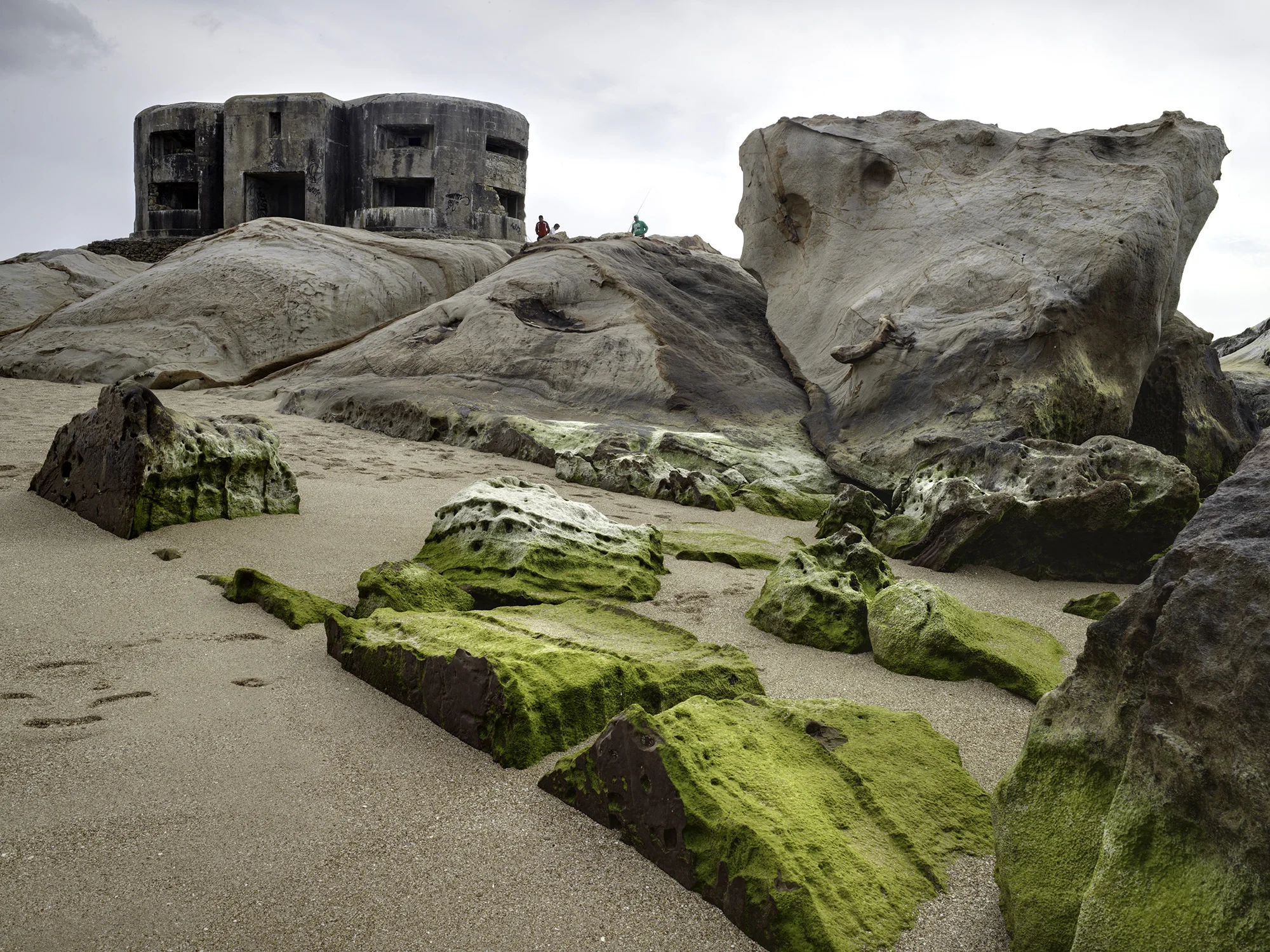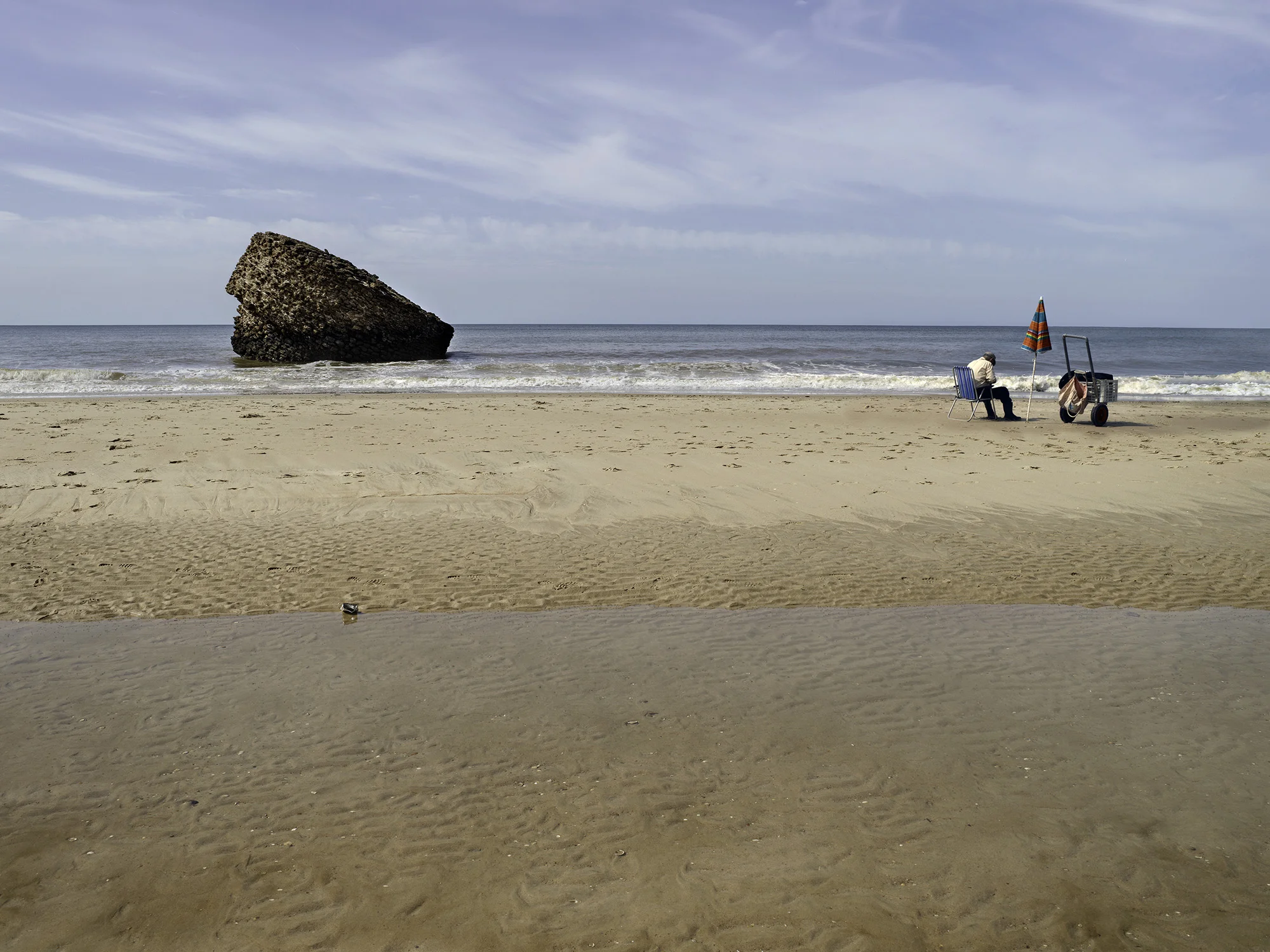
Moments Before The Flood
2012
The Coast: Question Mark of the Mainland
It now seems to be generally acknowledged that climate change, partly caused by human activity, will lead to a dramatic rise of the sea level in this century . Some predict an increase of tens of centimetres, others as much as a few metres. Moments Before the Flood is a visual, photographic investigation of Europe’s response to this unpredictable threat. The continent will feel the impact most keenly along its coasts, where the mainland feels less like solid ground, the Old World crumbles into the waves, and the future menaces the past. From the rocky West Coast of Ireland to the salt marshes and mud flats of the northern Netherlands and the beaches of the Aegean, the coast is a perennially unstable phenomenon, the question mark of the mainland. That is precisely what makes it such a fascinating subject for a photographic study of uncertainty. This project does not focus solely on the future hazard, but also looks at earlier forms of coastal protection in European history and reflects on how Fortress Europe is dealing with other kinds of flows and floods today.
The sixty-five thousand-kilometre coastline of Europe is strewn with useless defences from bygone ages. Many required enormous investments of materials and man-hours, but most never served any purpose. The enemy never came, or when they did, the structure proved obsolete. By the time the Germanic hordes invaded the late Roman Empire, the once-renowned Limes no longer posed much of a barrier, and even the Atlantic Wall could not stop the Normandy landings.
Moments Before the Flood investigates how Europe is preparing for the possibility of a dramatic rise of the sea level, and asks to what extent our efforts will ultimately prove futile. Are dyke reinforcements and seawalls the modern-day counterparts of those historic forts and defence lines? This series places great emphasis on that latent tension, on our inability to determine the reality of the threat and the effectiveness of our defences.
For four years, Carl De Keyzer spent four months a year travelling the coasts of Europe, driving some one hundred and twenty thousand kilometres. At first, he imagined he would focus on empty landscapes, desolate beaches, deserted hotels, piers in winter, skeletal harbour cranes, grim cliffs, and dramatic cloud formations. Yet little by little, people found their way into the pictures, some dressed in bathing suits, others in fitted suits hermits, tourists, waitresses, and dockworkers, the senseless hustle and bustle of sun-worshippers and other eccentrics. De Keyzer skilfully alternates ominous premonitions of doom with seemingly carefree seaside snaps. This creates the suspense, not of impending doom, but of its absence, a subliminal tension that makes trivial subjects tragic and everyday sights hilarious. Carl De Keyzer is interested in capturing not the disaster, but the waiting for the disaster with a layer of SPF thirty if necessary.
Above all, De Keyzer aims to discover how this long wait, and the defensive measures that accompany it, will shape the definition of Europe in the new millennium. Moments Before the Flood aspires to be the ultimate photographic document of waiting. It brings out the Unheimlichkeit, the ominous nature of the murky, uncertain future, and in the process it makes Europe seem literally unheimlich unhomelike. These photographs unsettle us. The Europe they show has become a waiting, idling continent.
In this book, De Keyzer draws connections between Dutch and British marine paintings, not simply because his theme is the sea, but because they convey a bizarre tension between threat and domesticity. He explains, The most dramatic sea battles, for instance, are depicted with dozens of galleons and storm clouds in the sky, but the paintings were often made in series and hung over the fireplace. Apparently, scenes of threat can bring delight a sense of beautiful danger, of pleasant horror.
This explains the consciously ambivalent flirtation with beauty in Moments Before the Flood. De Keyzer’s entire oeuvre is marked by a distrust of aesthetics. To him, beauty for its own sake is always suspect. He is constantly searching for an additional layer of meaning, and wherever possible a false bottom. In this series, he found one. The photographs are monumental in both their size and their resolution. De Keyzer has worked with sixty-five to eighty million pixels, an unprecedented degree of detail, made possible by the latest technology, which for the first time can produce a photograph that is sharper than a painting. This enables the viewer to read photographs at different levels and from different distances.
In this project, beauty is a kind of lure, capturing the viewers attention and drawing them into the scene. This is essential, because what at first appear to be aesthetically pleasing images turn out, upon closer inspection, to be filled with raw, hard-hitting themes. Beneath the inviting surface, they crackle with cruel realities.
Since the start of his career thirty years ago, Carl De Keyzer has never stood still, and in Moments Before the Flood, he takes a major new step in his oeuvre. After the dramatic black-and-white photography of his earliest books and the ironic, historiographic perspective of his work from the 1990s, he has become an almost detached observer, probing the boundaries of drama and aesthetics. This move is bold, but also inevitable. Like the coast that questions the mainland, these photographs question the very act of looking.
David Van Reybrouck


The Burren, Ireland

Portballintrae, Ireland

Dublin, Ireland

Dublin, Ireland

Sandycove, Ireland

Ballaghaline, Ireland

Galway, Ireland

Sandycove, Ireland

Harlech, UK

Brighton, UK

Folkestone, UK

West Bay, UK

Pembrokeshire, UK

Hastings, UK

Brighton, UK

Kimmerdige, UK

Tenby, UK

Thurso, UK

Pembrokeshire, UK

Morfa Nefyn, UK

Wallassey, UK

Conwy, UK

Barrow in Furness, UK

Stonehaven, UK

Whitby, UK

Keiss, UK

Staithes, UK

Penmon, UK

Thames Estuary, UK

Skipsea, UK

Edinburgh, UK

Skipsea, UK

Isle of Anglesey, UK

Ballantrae, UK

Dunure, UK

Isle of Anglesey, UK

Cullercoats, UK

Kilnsea, UK

Kilnsea, UK

Kirkcaldy, UK

Stonehaven, UK

Dunrobin, UK

Fort Augustus, UK

Fairbourne, UK

Beauvoir sur Mer, France

Trévou-Tréguignec, France

Sainte Marguerite sur Mer, France

Châtelaillon Plage, France

Vierville sur Mer, France

Hendaye, France

Boiro, Spain

Collioure, France

Saint Raphäel, France

Bonifiacio, Corsica, France

Nice, France

Barcelona, Spain

A Guarda, Portugal

Atlanterra, Spain

Tarifa, Spain

Porto do Son, Spain

Ruinas Torre Vigia, Spain

El Puerto de Santa Maria, Spain

Atlanterra, Spain

Lisbon, Portugal

Peniche, Portugal

Torres Vedras, Portugal

Miramar, Portugal

Fonte da Telha, Portugal

Tortoli, Italy

Monterossa al Mare, Italy

Leghorn, Italy

Naples, Italy

Noli, Italy

Naples, Italy

Livorno, Italy

Capo Testa, Italy

Ancona, Italy

Cefalu, Sicily, Italy

Isola de Capo Rizzuto, Italy

Aci Castello, Italy

Sestri Levante, Italy

Cariati, Italy

Augusta, Italy

Venice, Italy

Santa Casarea Terme, Italy

Mellieha, Malta

Mellieha, Malta

Comino, Malta

Novalja, Croatia

Kraljevica, Croatia

Muggia, Italy

Dubrovnik, Croatia

Bol, Croatia

Izola, Slovenia

Koper, Slovenia

Marina, Croatia

Miletici, Croatia

Petrovac, Montenegro

Malinska Dubasnica, Croatia

Shëngjin, Albania

Durrës, Albania

Durrës, Albania

Durrës, Albania

Durrës, Albania

Durrës, Albania

Durrës, Albania

Durrës, Albania

Valtaki, Greece

Patras, Greece

Mouresi, Greece

Preveza, Greece

Elefsina, Greece

Ouranopolis, Greece

Varna, Bulgaria

Rio, Greece

Budva, Montenegro

Continesti, Romania

Constanta, Romania

Varna, Bulgaria

Alesund, Norway

Sondre Hakvik, Norway

Vendesund, Norway

Frederikshavn, Denmark

Ystad, Sweden

Ystad, Sweden

Hjorring, Denmark

Hjorring, Denmark

Skarvbergtunnel, Finnmark, Norway

Tromso, Norway

Kvaenangen, Norway

Store Heddinge, Denmark

Borre, Denmark

Dragor, Denmark

Sliwin, Poland

Kolobrzeg, Poland

Leba, Poland

Sellin, Germany

Laboe, Germany

Ahrenshoop, Germany

Vrouwenpolder, Neeltje Jans, The Netherlands

Vrouwenpolder, Neeltje Jans, The Netherlands

Rotterdam, The Netherlands

Blankenberge, Belgium

Ostend, Belgium

Blankenberge, Belgium

Blankenberge, Belgium


















































































































































